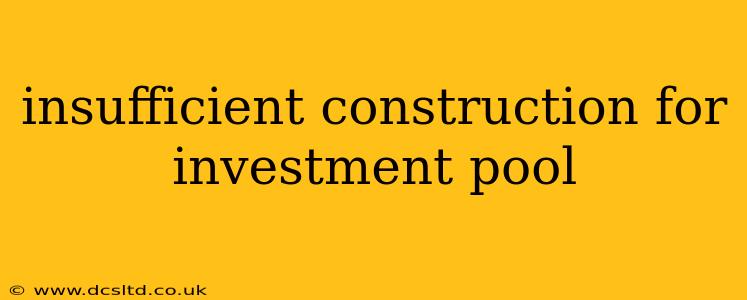Investing in construction projects offers significant potential returns, but insufficient construction can quickly derail even the most promising ventures. This article delves into the complexities of inadequate construction within investment pools, exploring the causes, consequences, and strategies for mitigating risk. We'll examine how to identify red flags, protect your investment, and ultimately, make informed decisions in this dynamic sector.
What Constitutes Insufficient Construction in an Investment Pool?
"Insufficient construction" encompasses a broad range of issues that ultimately compromise the value, safety, or functionality of a project. This could manifest in several ways:
- Substandard materials: Using cheaper, lower-quality materials than specified in the plans. This often leads to premature wear, increased maintenance costs, and potential safety hazards.
- Poor workmanship: Negligent or unskilled labor resulting in structural defects, flawed finishes, and non-compliance with building codes.
- Incomplete construction: Projects left unfinished or with critical elements missing, leading to significant delays and added expenses.
- Design flaws: Errors in the architectural or engineering plans that render parts of the structure unusable or unsafe.
- Lack of permits and inspections: Operating outside regulatory frameworks, creating legal and financial risks.
Why Does Insufficient Construction Occur in Investment Pools?
Several factors contribute to insufficient construction within investment pools:
- Cost-cutting measures: Pressure to minimize expenses can incentivize developers to compromise on quality.
- Lack of oversight: Inadequate monitoring and inspection of the construction process allow substandard work to go undetected.
- Unreliable contractors: Choosing inexperienced or unreliable contractors can lead to significant quality issues.
- Time constraints: Rushed construction schedules often prioritize speed over quality.
- Conflicts of interest: Conflicts between developers, investors, and contractors can hinder effective quality control.
How to Identify Insufficient Construction Before Investing
Due diligence is crucial. Before committing funds, consider these steps:
- Thorough background checks: Investigate the reputation of the developers and contractors involved.
- Independent inspections: Engage a qualified professional to assess the quality of construction at various stages.
- Review of building permits and inspections: Verify compliance with all relevant regulations.
- Detailed contract review: Ensure the contract clearly outlines the scope of work, materials specifications, and timelines.
- Financial analysis: Assess the financial stability of the developers and the project's budget.
What are the Consequences of Insufficient Construction in an Investment Pool?
The consequences of insufficient construction can be severe:
- Reduced property value: Substandard construction diminishes the asset's market value.
- Increased maintenance costs: Frequent repairs and replacements become necessary, eating into profits.
- Safety hazards: Structural defects and faulty workmanship pose significant safety risks.
- Legal liabilities: Non-compliance with building codes can lead to legal action and penalties.
- Delays and cost overruns: Remedial work adds time and expenses, delaying the project's completion.
How Can Investors Protect Themselves from Insufficient Construction?
Protecting your investment requires proactive measures:
- Comprehensive due diligence: Invest time and resources in thorough vetting of all aspects of the project.
- Strong legal agreements: Ensure contracts clearly define responsibilities and liabilities.
- Regular site visits and inspections: Monitor the construction progress closely.
- Independent quality control: Engage a qualified third-party inspector.
- Contingency planning: Build a buffer into your budget to account for unforeseen expenses.
What are the Legal Recourses Available to Investors?
If you discover insufficient construction, legal options might include:
- Contractual remedies: Seeking compensation for breaches of contract.
- Legal action against contractors: Filing lawsuits for negligence or breach of warranty.
- Mediation or arbitration: Exploring alternative dispute resolution methods.
Can Insurance Cover Losses from Insufficient Construction?
Specific insurance policies, like builders' risk insurance, might cover some losses related to insufficient construction. However, coverage varies significantly, depending on the policy terms and the cause of the problem.
How Can I Ensure My Investment Pool Avoids Insufficient Construction?
Investing in construction requires meticulous planning and management. Select reputable developers with proven track records, insist on rigorous quality control processes, and incorporate robust risk management strategies into your investment plan.
By understanding the causes and consequences of insufficient construction, and implementing preventative measures, investors can significantly reduce their risks and safeguard their investments. Remember, thorough due diligence and proactive risk management are paramount in navigating the complexities of construction investment pools.
